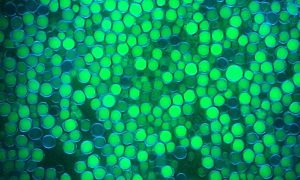A new paper published in the journal Science, MIT and Cambridge researchers at the startup company Novogy, have developed a new technique to that gives biofuel producers fermentation microbes that have the upper hand against unwanted invaders eliminating the need for antibiotics and other sterilization methods.
 The research was led by Gregory Stephanopoulos, the Willard Henry Dow Professor of Chemical Engineering and Biotechnology at MIT, and Joe Shaw, senior director of research and development at Novogy. They engineered microbes, such as Escherichia coli, with the ability to extract nitrogen and phosphorous – two nutrients needed for growth – from unconventional sources that could be added to the fermentation vessels.
The research was led by Gregory Stephanopoulos, the Willard Henry Dow Professor of Chemical Engineering and Biotechnology at MIT, and Joe Shaw, senior director of research and development at Novogy. They engineered microbes, such as Escherichia coli, with the ability to extract nitrogen and phosphorous – two nutrients needed for growth – from unconventional sources that could be added to the fermentation vessels.
Because the microbes only posses this advantage when they are fed these unconventional chemicals, there is little chance of them escaping and growing in an uncontrolled manner outside of the biofuel plant in a in a natural environment.
“We created microbes that can utilize some xenobiotic compounds that contain nitrogen, such as melamine,” Stephanopoulos said. Melamine is a xenobiotic, or artificial, chemical that contains 67 percent nitrogen by weight.
Conventional biofermentation refineries typically use ammonium to supply microbes with a source of nitrogen. But contaminating organisms, such as Lactobacilli, can also extract nitrogen from ammonium, allowing them to grow and compete with the producer microorganisms. In contrast, these organisms do not have the genetic pathways needed to utilize melamine as a nitrogen source, explained Stephanopoulos.
“They need that special pathway to be able to utilize melamine, and if they don’t have it they cannot incorporate nitrogen, so they cannot grow,” Stephanopoulos said.
The researchers engineered E. coli with a synthetic six-step pathway that allows it to express enzymes needed to convert melamine to ammonia and carbon dioxide, in a strategy they have dubbed ROBUST (Robust Operation By Utilization of Substrate Technology).
When the research team experimented with a mixed culture of the engineered E. coli strain and a naturally occurring strain, they found the engineered type rapidly outcompeted the control, when fed on melamine. They then investigated engineering the yeast Saccharomyces cerevisiae to express a gene that allowed it to convert the nitrile-containing chemical cyanamide into urea, from which it could obtain nitrogen. The engineered strain was then able to grow with cyanamide as its only nitrogen source. Finally, the researchers engineered both S. cerevisiae and the yeast Yarrowia lipolytica to use potassium phosphite as a source of phosphorous.
Like the engineered E. coli strain, both the engineered yeasts were able to outcompete naturally occurring strains when fed on these chemicals. In addition, the microbes were tested successfully on a variety of biomass feedstocks, including corn mash, cellulosic hydrolysate, and sugarcane, where they demonstrated no loss of productivity when compared to naturally occurring strains. The ROBUST strategy is now ready for industrial evaluation, added Shaw.

